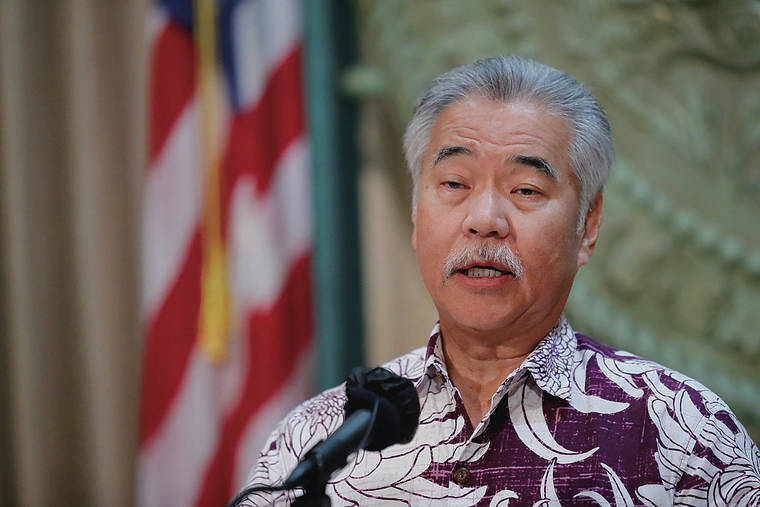Hawaii hospital capacity leading factor in reimposing restrictions

JAMM AQUINO/JAQUINO@STARADVERTISER.COM
”We do see that some of the breakthrough cases for unvaccinated individuals are relatively mild. So we are not seeing hospitalizations at the same way that occurred previously.”
Gov. David Ige
The state is using hospital capacity to decide whether more restrictions are necessary as the number of COVID-19 hospitalizations continue to increase.
Gov. David Ige expressed his concerns about the uptick in COVID-19 hospitalizations to the Honolulu Star-Advertiser’s Spotlight Hawaii livestream show Monday.
“We were doing so well,” Ige said. “The number of COVID patients in hospitals and ICUs all across the state was very, very low at the beginning of this eight- or nine-day spread,” he said.
“But we’ve seen a significant increase in the number of cases now that are in hospitals and that require intensive care and ventilators.”
Over the weekend the number of hospitalized COVID-19 patients increased to 90 from 74, and the number of people on ventilators nearly doubled.
ICU capacity statewide is at about 58%. However, Hawaii County is using the highest capacity of ICU beds and is at 75% capacity — although only two out of the 18 used beds are for COVID-19 cases.
Don't miss out on what's happening!
Stay in touch with breaking news, as it happens, conveniently in your email inbox. It's FREE!
While Hawaii overall has not yet reached critical levels for hospitalizations, Ige said capacity would be limited by restricting elective procedures.
“We do see that some of the breakthrough cases for unvaccinated individuals are relatively mild,” he said. “So we are not seeing hospitalizations at the same way that occurred previously. We are speaking with the hospital executives and talking about what steps would occur prior to taking more drastic action.”
After limiting elective procedures at hospitals, Ige said that the next restriction likely would be to limit the number of people allowed at small gatherings, which is now 25 indoors and 75 outdoors.
Currently, there is no “bright line” for hospital capacity that would cause the state to begin implementing restrictions. Ige said that is due to better treatment options for COVID-19 and because those who are vaccinated are not getting as sick as those who are not.
According to Lt. Gov. Josh Green, of those who are hospitalized, 96.6% are unvaccinated.
The state’s vaccination rate has slowed and is stalling just shy of 60%.
While the state has used federal COVID-19 relief funds to encourage people to get vaccinated, Ige noted that different incentives work for different communities.
“We definitely are looking at the rescue funds that we received, and are being thoughtful about what would make the most sense in getting people and encouraging people to get vaccinated,” he said.
While there have been no state mandates to vaccinate employees, Ige is considering implementing one for correctional facility workers. Before creating any vaccine mandate, the state wanted to wait for the vaccines to get a full approval from the Food and Drug Administration, alth0ugh it remains uncertain when that would happen.
“We’ve been asking about what that timeline looks like, and we really haven’t gotten a response that makes us feel comfortable,” he said. “So we are looking at what steps would be necessary to mandate that for employees ahead of FDA approval.”
Ige is sticking to the 70% vaccination rate as a benchmark for herd immunity, although some health experts have expressed the need to increase that vaccination rate to 80% or 90%.
“There’s really no bright line about what would constitute herd immunity,” Ige said. “We still think that the 70% is a good target.”
Molokai and Lanai have both reached 70% vaccination rates and have seen a reduction in cases compared with other islands, Ige said.
Honolulu has a vaccination rate of 62%, while Maui County has the state’s lowest rate at 54%.






